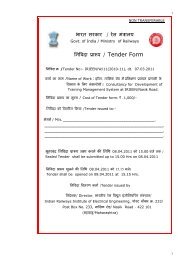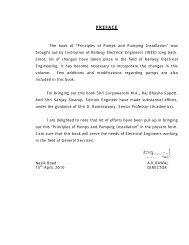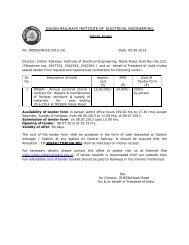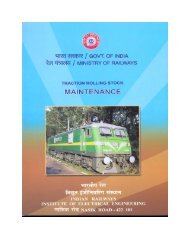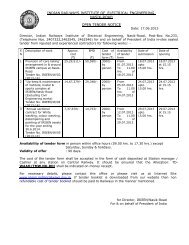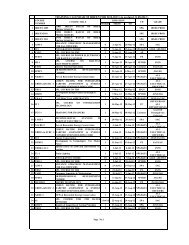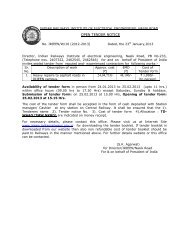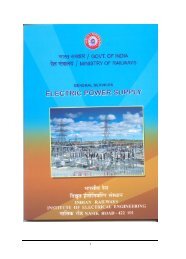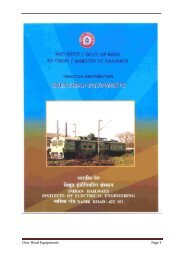remote control equipment - Indian Railways Institute of Electrical ...
remote control equipment - Indian Railways Institute of Electrical ...
remote control equipment - Indian Railways Institute of Electrical ...
Create successful ePaper yourself
Turn your PDF publications into a flip-book with our unique Google optimized e-Paper software.
Reduction factor Kc represents the relationship <strong>of</strong> the emf developed between a cable<br />
conductor and its sheath to the emf which appears between an insulated conductor and earth<br />
in the absence <strong>of</strong> sheath. This reduction factor depends on character and dimensions <strong>of</strong><br />
sheath and armouring and magnetic properties <strong>of</strong> the metal used for armouring. This improves<br />
as the frequency <strong>of</strong> the inducing current increases.<br />
For cables located at a little distance from the track Kc is smaller under heavy inductive<br />
conditions like short circuits than under less severe conditions like normal operation.<br />
Screening <strong>of</strong> cable sheaths can be improved by reducing the dc resistance <strong>of</strong> sheath and by<br />
increasing the mutual inductance between sheath and wires. Aluminium sheath has resistance<br />
<strong>of</strong> about 1/7 th <strong>of</strong> similar sized lead sheath. As against screening factor <strong>of</strong> 0.8 for lead sheathed<br />
cable for A1 sheathed cable it is 0.16. If the inductance is increased by steel tape armouring.<br />
Screening factor gets reduced to 0.025 and 0.2 respectively.<br />
The presence <strong>of</strong> metal work electrically connected to earth near the track, or the circuit<br />
subjected to induction exerts a reducing effect, which may be considerable especially when<br />
several cables are buried in same trench as they shield each other to certain extent.<br />
8.6 RAIL CURRENTS<br />
The rails form a conductor with rather uncommon qualities. The resistance is very small and<br />
the leakance very large. The attenuation is so large that the return current is diverted<br />
completely to earth after about few kilometers and with higher frequencies even sooner. If the<br />
distance between feeding and loading points is large enough and if the track is homogenous,<br />
the rail current divides equally in both directions at both points without any preference for the<br />
‘inside’ direction. Part <strong>of</strong> the current penetrates deep into the earth and some leaves the earth<br />
to find a path in cable sheaths, metal pipes and other similar conductor parallel to the track.<br />
Near the feeding point the whole <strong>of</strong> the current returns to the earthed end <strong>of</strong> the traction<br />
transformer winding through the rail/earth mat <strong>of</strong> the feeding point.<br />
If the return current could be wholly retained in the rails the inducing effect on an adjacent<br />
telephone line would be that from a comparatively narrow loop formed y the overhead wires<br />
and rails and would be relatively small. In practice the load current rapidly leaves the rails for<br />
earth as shown in fig. 8.4 (b) which is applicable to an electrically long section where the rails<br />
continue for some distance on either side <strong>of</strong> the section.<br />
The rails will however themselves be subjected to an induced voltage from the overhead wire<br />
which will cause a current to flow in the rails virtually in the opposite direction to the contact<br />
wire current as shown in fig. 8.4 (c).<br />
In the centre <strong>of</strong> a long section the value <strong>of</strong> this current will be uniform and is equal to the<br />
induced voltage divided by the series impedence <strong>of</strong> the rails.<br />
149




